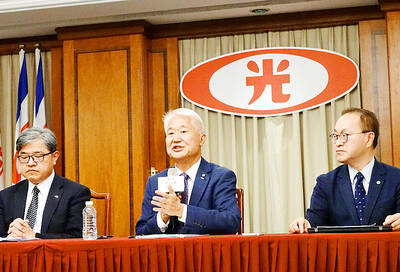Workers were close to restoring power to a nuclear plant’s overheating reactors yesterday as the toll of dead or missing from Japan’s worst natural disaster in nearly a century neared 21,000.
Amid the devastation on the northeast coast left by the March 11 earthquake and tsunami, police reported an astonishing tale of survival with the discovery of an 80-year-old woman and her 16-year-old grandson alive under the rubble.
“Their temperatures were quite low, but they were conscious. Details of their condition are not immediately known. They have been already rescued and sent to hospital,” a spokesman for the Ishinomaki Police Department said.
They were in the kitchen when their house collapsed, but the teenager was able to reach food from the refrigerator, helping them survive for nine days, broadcaster NHK quoted rescuers as saying.
However, with half a million tsunami survivors huddled in threadbare, chilly shelters and the threat of disaster at the Fukushima Dai-ichi nuclear plant stretching frayed nerves, the mood in the world’s third-biggest economy remained grim.
The discovery of traces of radioactive iodine in Tokyo tap water, well to the southwest of the crippled atomic power plant on the Pacific coast, compounded public anxiety, but authorities said there was no danger to health.
The Fukushima Dai-ichi plant was struck on March 11 by a massive earthquake and tsunami which, with 8,199 people confirmed killed, is Japan’s deadliest natural disaster since the Great Kanto quake leveled much of Tokyo in 1923.
Another 12,722 are missing, feared swept out to sea by the 10m tsunami or buried in the wreckage of buildings. In Miyagi Prefecture on the northeast coast, where the tsunami reduced entire towns to splintered matchwood, the official death toll stood at 4,882.
However, Miyagi police chief Naoto Takeuchi told a task force meeting that his prefecture alone “will need to secure facilities to keep the bodies of more than 15,000 people,” Jiji Press reported.
Cooling systems that are meant to protect the Fukushima Dai-ichi plant’s six reactors from a potentially disastrous meltdown were knocked out by the tsunami, and engineers have since been battling to control rising temperatures.
The radiation-suited crews were striving to restore electricity to the aging facility 250km northeast of Tokyo, after extending a high-voltage cable into the site from the national grid.
A spokesman for Japan’s nuclear safety agency said electricity had apparently reached the power distributor at reactor 2, which in turn would feed power to reactor 1.
Plant operator Tokyo Electric Power Co (TEPCO) confirmed an electricity supply had been restored to the distributor, but said power at the reactor unit was not back on yet.
Engineers were checking the cooling and other systems at the reactor, aiming to restore power soon, TEPCO said late yesterday.
“It will take more time. It’s not clear when we can try to restore the systems,” spokesman Naohiro Omura said.
Fire engines earlier aimed their water jets at the reactors and fuel rod pools, where overheating is an equal concern, dumping thousands of tonnes of seawater from the Pacific Ocean.
Six workers at the Fukushima Dai-ichi plant have been exposed to high levels of radiation, but are continuing to work and have suffered no health problems, TEPCO said.

People can preregister to receive their NT$10,000 (US$325) cash distributed from the central government on Nov. 5 after President William Lai (賴清德) yesterday signed the Special Budget for Strengthening Economic, Social and National Security Resilience, the Executive Yuan told a news conference last night. The special budget, passed by the Legislative Yuan on Friday last week with a cash handout budget of NT$236 billion, was officially submitted to the Executive Yuan and the Presidential Office yesterday afternoon. People can register through the official Web site at https://10000.gov.tw to have the funds deposited into their bank accounts, withdraw the funds at automated teller

PEACE AND STABILITY: Maintaining the cross-strait ‘status quo’ has long been the government’s position, the Ministry of Foreign Affairs said Taiwan is committed to maintaining the cross-strait “status quo” and seeks no escalation of tensions, the Ministry of Foreign Affairs (MOFA) said yesterday, rebutting a Time magazine opinion piece that described President William Lai (賴清德) as a “reckless leader.” The article, titled “The US Must Beware of Taiwan’s Reckless Leader,” was written by Lyle Goldstein, director of the Asia Program at the Washington-based Defense Priorities think tank. Goldstein wrote that Taiwan is “the world’s most dangerous flashpoint” amid ongoing conflicts in the Middle East and Russia’s invasion of Ukraine. He said that the situation in the Taiwan Strait has become less stable

CONCESSION: A Shin Kong official said that the firm was ‘willing to contribute’ to the nation, as the move would enable Nvidia Crop to build its headquarters in Taiwan Shin Kong Life Insurance Co (新光人壽) yesterday said it would relinquish land-use rights, or known as surface rights, for two plots in Taipei’s Beitou District (北投), paving the way for Nvidia Corp to expand its office footprint in Taiwan. The insurer said it made the decision “in the interest of the nation’s greater good” and would not seek compensation from taxpayers for potential future losses, calling the move a gesture to resolve a months-long impasse among the insurer, the Taipei City Government and the US chip giant. “The decision was made on the condition that the Taipei City Government reimburses the related

FRESH LOOK: A committee would gather expert and public input on the themes and visual motifs that would appear on the notes, the central bank governor said The central bank has launched a comprehensive redesign of New Taiwan dollar banknotes to enhance anti-counterfeiting measures, improve accessibility and align the bills with global sustainability standards, Governor Yang Chin-long (楊金龍) told a meeting of the legislature’s Finance Committee yesterday. The overhaul would affect all five denominations — NT$100, NT$200, NT$500, NT$1,000 and NT$2,000 notes — but not coins, Yang said. It would be the first major update to the banknotes in 24 years, as the current series, introduced in 2001, has remained in circulation amid rapid advances in printing technology and security standards. “Updating the notes is essential to safeguard the integrity